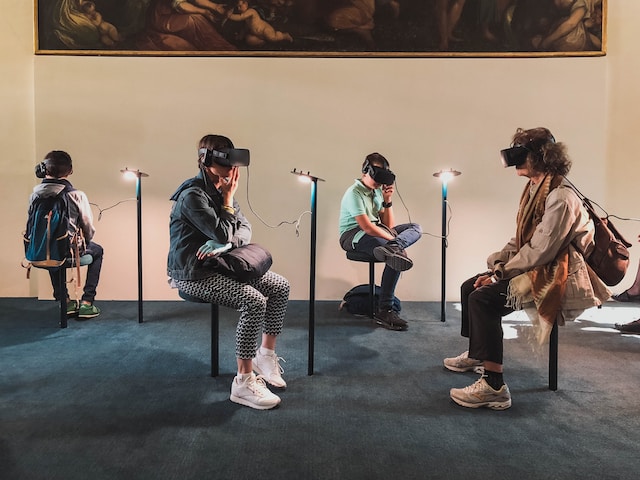
Unveiling the Horizon: The Future of Augmented Reality Across Industries
Augmented Reality (AR), a technological marvel that overlays digital information on the physical world, has garnered attention for its transformative potential across diverse industries. Advocates envision a future where AR enhances experiences, revolutionizes workflows, and redefines how we interact with our surroundings. However, skeptics raise concerns about privacy, potential misuse, and the need for careful implementation. In this exploration, we will navigate the landscape of the future of Augmented Reality, dissecting its promises and potential pitfalls with an unbiased lens.
The Enthusiasts’ Perspective: AR’s Promised Utopia
Advocates of AR highlight the following potential advantages across industries:
1. Enhanced User Experiences:
- AR promises to elevate user experiences by blending digital elements seamlessly with the physical world, offering interactive and immersive encounters.
2. Improved Productivity in Manufacturing:
- In manufacturing, AR has the potential to streamline processes, providing workers with real-time information, reducing errors, and enhancing efficiency.
3. Revolutionizing Retail:
- Advocates envision AR transforming the retail landscape with virtual try-ons, interactive product displays, and personalized shopping experiences.
4. Augmented Learning in Education:
- AR applications in education could revolutionize learning by providing interactive and dynamic content, enhancing engagement and understanding.
5. Healthcare Innovation:
- AR is seen as a tool for medical professionals, offering augmented visualization during surgeries, remote assistance, and training simulations.
The Skeptics’ Concerns: Navigating the Shadows of AR’s Rise
Skeptics and critics may raise the following concerns or considerations:
1. Privacy and Security Risks:
- Critics express concerns about the potential invasion of privacy through AR, highlighting the need for robust security measures to protect user data.
2. Ethical Considerations:
- Skeptics emphasize the importance of addressing ethical concerns related to AR, such as potential misuse for surveillance or manipulative advertising.
3. Dependency and Distraction:
- Critics caution against the potential for increased dependency on AR, raising concerns about distractions in various settings, including driving or walking in public spaces.
4. Accessibility Challenges:
- Skeptics may point out potential accessibility challenges, particularly for individuals who may not have access to AR devices or have difficulty using them.
5. Economic Disparities:
- Concerns are raised about the potential exacerbation of economic disparities, as AR adoption may be more accessible to certain industries or wealthier individuals.
AR’s Potential Impact Across Industries
AR’s transformative potential is evident in various industries, each with its unique considerations:
1. Gaming and Entertainment:
- AR is redefining gaming experiences with location-based augmented reality games and immersive storytelling.
2. Architecture and Design:
- In architecture, AR allows professionals to visualize designs in real-world environments, enhancing collaboration and decision-making.
3. Navigation and Tourism:
- AR is transforming navigation and tourism with interactive guides, real-time information overlays, and virtual explorations.
4. Social Media and Communication:
- AR is shaping the future of social media, enabling users to share augmented content and experiences with their online communities.
5. Remote Collaboration:
- The workplace benefits from AR-enabled remote collaboration tools, offering virtual meetings, real-time data sharing, and interactive workflows.
Striking a Balance: Navigating the AR Landscape Responsibly
In navigating the future of Augmented Reality, it is essential to strike a balance that harnesses its potential benefits while addressing concerns. This involves:
1. Ethical AR Development:
- Prioritize ethical considerations in AR development, ensuring responsible data usage, transparency, and user consent.
2. Privacy Safeguards:
- Implement robust privacy safeguards to protect user data and mitigate the risk of unauthorized access or misuse.
3. Accessibility Initiatives:
- Work towards making AR technology more accessible, addressing barriers to entry and ensuring inclusivity.
4. Public Awareness and Education:
- Foster public awareness and education about AR, providing information on its capabilities, risks, and responsible usage.
5. Regulatory Frameworks:
- Advocate for clear and adaptable regulatory frameworks that balance innovation with consumer protection and ethical standards.
In Conclusion: Navigating the Augmented Future
As we navigate the future of Augmented Reality, it is essential to approach this transformative technology with a cautious yet curious mindset. Whether one is captivated by the promises of enhanced experiences or remains skeptical about potential risks, a nuanced and informed perspective is key to steering the course of AR’s evolution responsibly and shaping a future where its potential benefits are maximized for the greater good.
